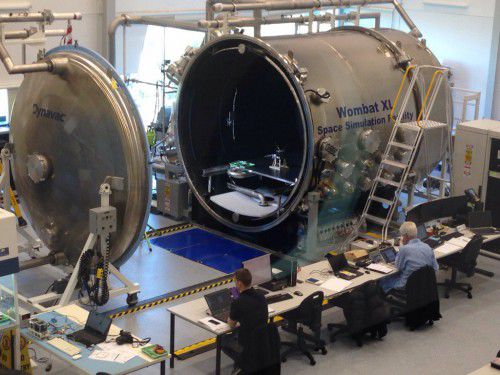RESEARCHERS from around Australia have begun testing satellites at the Mount Stromlo space testing facilities at The Australian National University (ANU) ahead of a mass satellite launch from the International Space Station later this year.
Facility manager Mike Petkovic says the three CubeSats, satellites built from cubes about 10 centimetres per side, have been developed by researchers at ANU, the University of Sydney, UNSW, University of Adelaide and the University of South Australia. They will be launched into space as part of the European Union’s QB50 launch of 50 satellites.
“Before heading into space, the satellites will undergo rigorous tests in the ANU space simulator at the Advanced Instrumentation Technology Centre (AITC) at Mount Stromlo to make sure they are space ready,” Mike said.
“It is very pleasing to see satellites being built and tested in Australia again. With the new AITC facilities this will be the beginning of a sustained activity in Australia that benefits universities and industry.
“The European Union QB50 program has 27 countries building satellites for the mass launch from the International Space Station, including China, US, Brazil and Russia.
“The ANU Centre at Mount Stromlo provides researchers and industry with a comprehensive one-stop shop for pre-launch testing. It will play an important role in the growing multi-million-dollar space industry.
“CubeSats are emerging as a space industry standard design for low-cost space research. Originally conceived for student projects, more than 100 CubeSats have now been launched around the Earth and even around Mars.
One of the three Australian CubeSats is being developed by ANU, University of Sydney and UNSW. It carries an impressive payload of Australian-designed instruments, said collaboration leader Professor Iver Cairns from University of Sydney.
“These first three Australian CubeSats in space will be doing research with significant public good. For example, they are looking at space weather and solar activity, which are important for vital systems such as GPS, financial systems and electricity grids,” said Professor Cairns, who is also the Secretary General of the Australasian Space society.
The CubeSat, which has been developed in collaboration with UK and Norwegian scientists, carries radiation counters, a GPS receiver, a photonic spectrograph, and a new probe to measure the ionosphere.
A second CubeSat will carry new instruments to measure atmospheric water and carbon dioxide. It was developed by University of Adelaide and University of South Australia with support from the South Australian Government and the Sir Ross and Sir Keith Smith fund.
The data from the new instruments will be in demand from weather and climate scientists, said Dr Matthew Tetlow from the University of Adelaide.
“This is a big opportunity to develop innovative technology. It has really ramped up our ability to compete at an international level,” Dr Tetlow said.
UNSW have built a third CubeSat, which will carry four separate experiments into orbit, including a specially designed GPS receiver and electronics with the ability to self-repair, said space engineer Dr Joon Wayn Cheong, from UNSW.
“If the satellite gets hit by radiation and something breaks, we want to be able to reconfigure another part of the circuit to do that job, as well as fix the broken bit,” he said.
[Photo via Twitter]
Who can be trusted?
In a world of spin and confusion, there’s never been a more important time to support independent journalism in Canberra.
If you trust our work online and want to enforce the power of independent voices, I invite you to make a small contribution.
Every dollar of support is invested back into our journalism to help keep citynews.com.au strong and free.
Thank you,
Ian Meikle, editor





![For graphic designer Tracy Hall, street art is like any artwork, her canvas has been swapped out for fences and plywood, her medium changing from watercolours to spray paint.
A Canberra resident for 13 years, Tracy has been a street and mural artist for the past five.
Her first exploration into grand-scale painting was at the Point Hut toilets in Banks five years ago. “They had just finished doing up the playground area for all the little kids and the words [of graffiti] that were coming up weren’t family friendly,” she says.
“So I ended up drawing this design and I got approval for the artwork.”
Many of Tracy’s time-consuming artworks are free, with thousands of her own dollars put into paint.
@traceofcolourdesigns
To read all about Tracy's fabulous street art, visit our website at citynews.com.au or tap the link in our bio! 🎨🖌
#canberranews #citynews #localstories #canberrastories #Citynews #localnews #canberra #incrediblewomen #journalism #canberracitynews #storiesthatmatter #canberralocals #artist #streetart #streetartist #StreetArtMagic](https://scontent.cdninstagram.com/v/t39.30808-6/490887207_1225841146218103_6160376948971514278_n.jpg?stp=dst-jpg_e35_tt6&_nc_cat=106&ccb=1-7&_nc_sid=18de74&_nc_ohc=MUiEmedc4VAQ7kNvwHTUMX_&_nc_oc=Adk-5HjcsfQwB-n_l8zetmr0YqMaupGjrl2gNVCZdsmkxwn-oqjBg_V7pLtGggCE43s&_nc_zt=23&_nc_ht=scontent.cdninstagram.com&edm=ANo9K5cEAAAA&_nc_gid=zUGxMxVeox-VfFZv4iA87g&oh=00_AfFN09hwx4fLSDKDRM6X1bOHHeJViuNl97HnpBuFpR5hfA&oe=680B8C14)



Leave a Reply